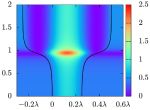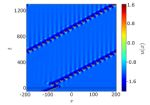News
EPJ B Colloquium - Tensor network theory
- Details
- Published on 01 December 2014

Tensor Network (TN) states are a new language, based on entanglement, for quantum many-body states. Román Orús, in a new EPJ B Colloquium, reviews four theoretical developments in TN states for strongly correlated systems.
EPJ D Highlight - Atoms crystallised by light for precision measurement
- Details
- Published on 26 November 2014

A new study focuses on the collective dynamics of illuminated atoms coupled to photons travelling in a nanofiber
Theoretical physicists have uncovered the existence of self-organised dynamics of atoms, bound by light into a crystal, with long range atom-atom interactions. These findings were recently published in EPJ D by Daniela Holzmann from the University of Innsbruck, Austria, and colleagues. This approach could, among others, help to better understand the process of crystallisation in new materials, and help implement efficient photon storage and precision measurements. Applied to ultra-cold atoms, it could aid in the study of long-distance interactions in the quantum dynamics of one-dimensional non- conventional materials, referred to as exotic matter.
EPJ B Highlight - Taming neural excitations
- Details
- Published on 25 November 2014

A theoretical study of short- and long-range effects on neural excitation pulses might one day lead to controlling harmful signals such as those in strokes
What do lasers, neural networks, and spreading epidemics have in common? They share a most basic feature whereby an initial pulse can propagate through a medium—be it physical, biological or socio-economic, respectively. The challenge is to gain a better understanding—and eventually control—of such systems, allowing them to be applied, for instance to real neural systems. This is the objective of a new theoretical study published in EPJ B by Clemens Bachmair and Eckehard Schöll from the Berlin University of Technology in Germany. Ultimately, with a better theoretical understanding, scientists aim to control such excitations in networks of neurons to prevent their detrimental effects like in stroke.
EPJ D Colloquium - Multiscale approach to the physics of radiation damage with ions
- Details
- Published on 24 November 2014

In this EPJ D Colloquium, the authors review the multiscale approach to the assessment of biodamage that results from the irradiation of biological media with ions. This approach is explained in depth and compared to other approaches. The ion propagation processes that take place in the medium concurrent with ionisation and excitation of molecules, transport of secondary products, dynamics of the medium, and biological damage, take place on a number of different temporal, spatial and energy scales. The multiscale approach, a physical phenomenon-based analysis of the scenario that leads to radiation damage, has been designed to consider all relevant effects on a variety of scales and to enable quantitative assessment of biological damage as a result of irradiation with ions.
EPJ D Colloquium - Laser selective spectromicroscopy of myriad single molecules: tool for far-field multicolour materials nanodiagnostics
- Details
- Published on 14 November 2014

In this EPJ D Colloquium, the authors discuss the main principles, achievements and perspectives in the fields of highly-parallel luminescence spectroscopy and the imaging of single molecules (SMs) in transparent solids. Special attention is given to SM detection at low temperatures, where ultranarrow and bright zero-phonon lines (ZPLs) can be generated by emitting centres for observation.
EPJ H Highlight - Penrose’s and Hawking’s early math award
- Details
- Published on 11 November 2014

Find out how Roger Penrose and Stephen Hawking won recognition for their work on space time singularities back in the sixties, suggesting an initial start to the universe
In 1966, it was Roger Penrose who won the prestigious Adams prize for his essay: An Analysis of the Structure of Space Time. The Adams prize—named after the British mathematician John Couch Adams—is awarded each year by the Faculty of Mathematics at the University of Cambridge to a young, UK-based mathematician. At the same time, Stephen Hawking won an auxiliary to the Adams prize for an essay entitled Singularities and the Geometry of Spacetime, shortly after completing his PhD. A copy of the original submission has now been reproduced in EPJ H.
EPJ B Video - Competent Editorial Staff and Quick Handling System
- Details
- Published on 10 November 2014
Here's why you should publish your article on condensed matter or complex systems in EPJ B.
EPJ B Colloquium - Femto-nano-optics: ultrafast nonlinearity of metal nanoparticles
- Details
- Published on 05 November 2014

A deep understanding of the internal dynamics of metal nanoparticles, through the measurement of their time resolved optical response, requires detailed modeling of the physical processes involved. This EPJ B Colloquium explores the nonlinear ultrafast optical response of metal nanoparticles which can be obtained experimentally in ensembles and single nanoparticles, through femtosecond pump-probe spectroscopy.
EPJ B Highlight - On-demand conductivity for graphene nanoribbons
- Details
- Published on 05 November 2014

Physicists from Uzbekistan and Germany have devised a theoretical model to tune the conductivity of graphene zigzag nanoribbons using ultra-short pulses
Physicists have, for the first time, explored in detail the time evolution of the conductivity, as well as other quantum-level electron transport characteristics, of a graphene device subjected to periodic ultra-short pulses. To date, the majority of graphene studies have considered the dependency of transport properties on the characteristics of the external pulses, such as field strength, period or frequency. The new findings have now been published in EPJ B by Doniyor Babajanov from the Turin Polytechnic University in Tashkent, Uzbekistan, and colleagues. These results may help to develop graphene-based electronic devices that only become conductors when an external ultra-short pulse is applied, and are otherwise insulators.
EPJ D Highlight - Plasma: Casimir and Yukawa mesons
- Details
- Published on 29 October 2014

The Casimir electromagnetic fluctuation forces across plasmas are analogous to so-called weak nuclear interaction forces, as new findings show
A new theoretical work establishes a long-sought-after connection between nuclear particles and electromagnetic theories. Its findings suggests that there is an equivalence between generalised Casimir forces and what are referred to as weak nuclear interactions between protons and neutrons. The Casimir forces are due to the quantisation of electromagnetic fluctuations in vacuum, while the weak nuclear interactions are mediated by subatomic scale particles, originally called mesons by Yukawa. These findings by Barry Ninham from the Australian National University, in Canberra, and European colleagues, have now been published in EPJ D.



